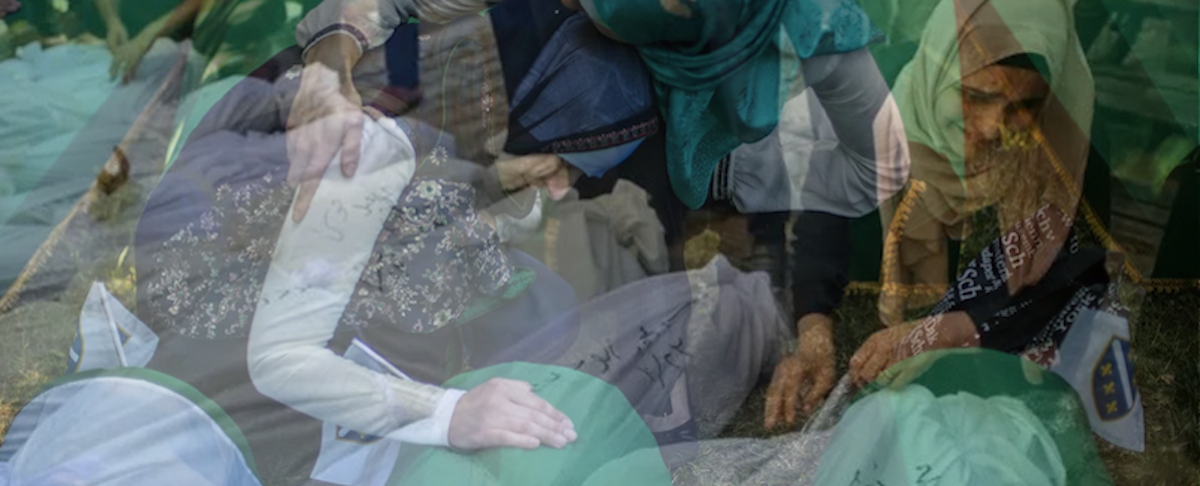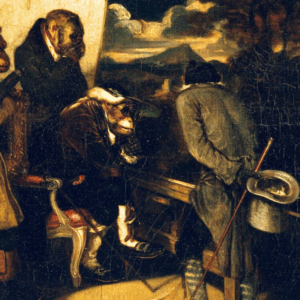
Dr. Seema Jilani on the Dark Parallels Between Srebrenica and Gaza
“A maligned Muslim people, abandoned by their brothers and dehumanized by the West...”
More journalists have been killed in Gaza than in both world wars, the Vietnam War, the wars in Yugoslavia, and the US war in Afghanistan combined, making it the deadliest conflict for media workers ever recorded. As international journalists have been banned from entering Gaza, foreign aid workers have had to step into the role of providing eyewitness testimonies for Western audiences.
Back in December 2023, I became one of the first doctors allowed into Gaza, where I worked until our hospital received a bullet through the intensive care unit, until Israeli forces surrounded the building, until leaflets with evacuation orders rained down from the sky.
When I returned to the US, I shared accounts of children exsanguinating on their own blood, of cradling a man as he took his final breaths, of charred teenagers gasping for their dead mothers. Members of the UN Security Council, the National Security Council, and senior White House officials, as well as multiple media outlets, have all heard these stories. Plausible deniability died long ago.
I have seen this before. This year marks the 30th anniversary of the Srebrenica Genocide, when Serb forces systematically slaughtered over 8,000 Bosnian Muslims and dumped their bodies into mass graves. Like every other year, remains have been excavated. DNA has been matched to survivors. Burials have taken place at a July 11 commemoration service—a despondent attempt at closure for grieving families. I have identified remains from mass graves, documented the beats of the massacre, and attended the trials of war criminals at the International Court Tribunal of Yugoslavia. Every Bosnian Muslim I have ever met is acutely aware that the international community knew they were being hemmed into concentration camps in Europe’s backyard, knew they were being starved, knew about the infamous rape camps.
I once identified the bones of a Bosnian Muslim boy. They were discovered in four different mass graves, two of which were about twelve miles apart.
The world knew and did nothing. That’s not entirely true. The international community placed a weapons embargo on both the Serbian and Bosnian military forces, but Serbia had access to the robust army and weapons stockpiles of the former Yugoslavia. Bosnia had no such luxury.
“I was twenty-eight years old when my love was murdered,” says Zlata Mujic in a Sarajevo café. She lost a total of eleven family members, including her husband and father, in the Srebrenica Genocide. For years, Zlata knew nothing of her husband’s fate. It took advancements in DNA testing for his death to be confirmed.
“They told me his body was dumped into the Drina River first,” she says. “But his legs were found in one grave, his hands in another. His head was never found.” Zlata eventually buried what scraps of him she had.
“Since that day, I am just breathing, not living,” she says.
I once identified the bones of a Bosnian Muslim boy. They were discovered in four different mass graves, two of which were about twelve miles apart. I dusted through mandibles and femurs. It became my responsibility to kill the hope that someone’s child was still alive.
When we comb through the layers of complicity, we find more than just power-hungry politicians and bloodthirsty generals.
Body bags piled ten-feet high at the International Commission for Missing Persons transported me back to the anatomy lab. The same nauseating stench of rancid bodies. The war had been over for more than a decade. Relics exhumed from communal graves were sometimes the only proof of a life: defunct guitar strings told of house parties, of raucous cheering and clinking glasses of sljivovica; a crushed notebook held faded love letters; the clasp of a necklace that would have rested on a woman’s nape, where her lover worshipped her. These artifacts implore us to pay attention, to ensure that the next time genocide is inflicted upon a people, we do more than just bear witness their suffering. They beg us to risk something—a name, a career, a book deal, a social standing, anything—by screaming at the top of our lungs that these were, are, real people; not just ghosts floating in the ether.
The corrosive idea that evil happens out there is what sustains our indifference. We never imagine ourselves, or those in our community, capable of true evil. That is, until it’s your neighbor who executes your son, your child’s teacher who makes you watch as he rapes your daughter. Only then are we forced to wrestle with the true brutality of war.
When we comb through the layers of complicity, we find more than just power-hungry politicians and bloodthirsty generals. Someone had to have dug the pit, stacked the corpses, bulldozed over the mass graves. This, too, is where savagery lurks—in tedious, monotonous tasks. Gardening. Driving. Hannah Arendt called it the “banality of evil.” I view it as the regalia of evil: the detachment that complicity breeds is the evil itself.
General Ratko Mladic was the architect of the Srebrenica Genocide. He lived freely in Serbia for years afterwards, hailed as a hero by many. There is even footage of Mladic dancing at his daughter’s wedding prior to his trial at The Hague.
While he danced, genocide survivors were searching for remnants of their loved ones. A son’s watch, the ragged threads of a boyfriend’s shoelaces, a patch of a husband’s threadbare acid washed Levis. The beats of a life are contained within these remnants: a coy flirt on the Adriatic Sea, a first kiss, couples fighting and making up. Pregnancy cravings, bubble baths, first steps. Instead of those memories, survivors are left with the morbid archives of loss. Wires tying people’s hands behind their backs; blindfolds for mass executions; a blood-stained ID card, caked in Bosnian earth, denoting the ill-fated ethnicity: Bosnian Muslim. Bosniak.
Every year, residents of nearby Serb-populated towns discourage and even protest the commemoration of the Srebrenica Genocide. They want survivors to shut up, to move on, to forget
I watch the trail of women come and go. One recognizes the tag to her husband’s favorite t-shirt—the one she loved to wear in the mornings while they sipped their coffee in bed. Him, reading the paper, her recounting last night’s dinner party gossip. His shirt sat big on her, exposing her left shoulder. He couldn’t fall asleep at night without breathing against that shoulder, she tells me. It began as a torrid love affair. Time dissolved in fingers rolling through unruly hair and toes curling under covers. Then came the era of impromptu, barefoot living room dances—the ones that save marriages. There are no wedding photos of them, no concert tickets, no mix tapes. No proof of their togetherness. Just DNA from his teeth and a red-splattered t-shirt tag.
Another woman closed her eyes as she resurrected her husband’s memory with a glimpse of his cigarette lighter.
“I asked for a drag from his cigarette when we first met. He leaned in so close I could feel his warm breath on my collarbone,” she recalled. “His cigarette, clasped between his two fingers, met my lips, daring me to touch them. I inhaled. His fingers lingered on my lips and immediately, I was intoxicated by him.”
She recognized the lighter. It’s him, he’s really gone.
Every year, residents of nearby Serb-populated towns discourage and even protest the commemoration of the Srebrenica Genocide. They want survivors to shut up, to move on, to forget, but Hasan Nuhanovic refuses to forget. A translator for the UN peacekeeping forces during the war, Hasan was forced to translate to his father and brother that they had to leave Srebrenica under Mladic’s orders, knowing they would be slain. When Hasan and I first met, more than fifteen years ago, he told me he once traded $1,000 worth of black-market tobacco for a three-minute phone call with his girlfriend (now wife) during which he strummed his guitar for her. Hasan now avoids visits to Srebrenica, but when he absolutely must go, he says:
I listen to music in the car to distract me, but I have to turn it off because I pass a mass execution site. Twenty minutes later I turn the music on again. Within a few minutes, I must turn it off because I know there is a mass grave on the side of the road. And for another hour’s drive, I cannot turn my music on again because the entire area is bursting with the voices of the dead in all those mass graves.
Hasan would go on to sue the UN for complicity in war crimes committed in Srebrenica.
“We were abandoned. It was an open season on Muslims,” Hasan said. The so-called Muslim brethren countries didn’t think Bosnians were Muslim enough to stand in solidarity with, while the Western world deemed them too Muslim to be fully human. Too Muslim to save.
A maligned Muslim people, abandoned by their brothers and dehumanized by the West. Plus ça change.
The international community infamously dropped inedible cans of ICAR “beef,” which even the ragged war cats would retch over. Some of the cans, which were dropped onto a largely Muslim population, contained pork, while others were over twenty years expired—leftovers from the Vietnam War. Years later, a sculpture was erected in Sarajevo to memorialize these “aid” drops: a gigantic replica of an ICAR beef can above the caustic inscription, “With Eternal Thanks to the International Community, From the Grateful Citizens of Sarajevo.”
Zlata and I are sitting not far from this monument when she says, scathingly, “This year, I will bury him for the hundredth time. Where were you when the Drina River was overflowing with the blood of my husband?”
I used to wonder what the post-war sculpture in Gaza might depict. A NICU incubator, occupied but abandoned? A child amputee, waiting for the parents who will never appear at her bedside? Maybe a crumpled, bullet-riddled aid package from the Gaza Humanitarian Foundation?
But after twenty-two months of slaughter and starvation, I wonder instead who among the Palestinian people will still be breathing; who will still have blood pulsing enough to create the sculpture that mocks the world for its apathy.
Seema Jilani
Seema Jilani is a pediatric specialist who has worked in Afghanistan, Gaza, the West Bank, Lebanon, Iraq, Syria, Egypt, Bosnia, and on refugee rescue boats off the coast of Libya. Her radio documentary, Israel and Palestine: The Human Cost of the Occupation, was nominated for the Peabody award.












